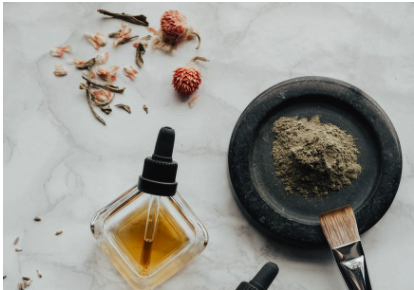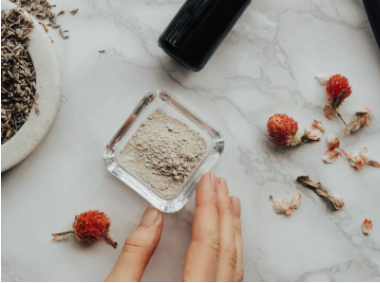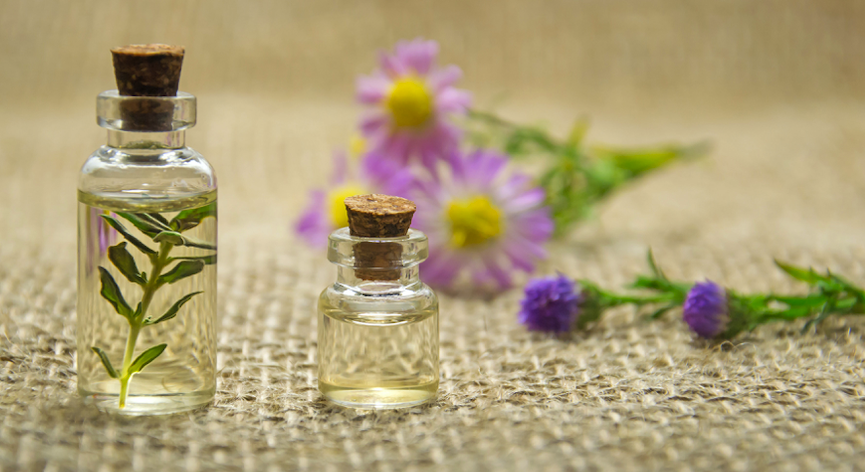Aromatherapy, a kind of alternative medicine that uses plant extracts to enhance health and well-being, Essential oils are ofter used in aromatherapy.
The volatile aromatic oils that give plants their distinctive scents and contain their pharmacological properties are known as essential oils. Distillation or expression are used to extract them from plants. These oils can be found in the minute droplets of aromatic substances released when mint or thyme leaves are crushed, Essential oils, according to biologists, contain more chemicals than all of the world’s chemists could produce in a thousand years. Terpenes, phenols, aldehydes, and alcohols with antibacterial characteristics are among these chemicals. They’re one of nature’s most potent antibiotics.

Route of Administration
Essential oils can be taken orally, as an ointment on the skin, or by Inhalation (from steams, vapours, smoke, etc.). Their tissue-distribution potential is immense. They will have entered the bloodstream few minutes after being spread on the skin. They are in the lungs twenty minutes to two hours later, being exhaled with every breath.Because essential oils are extremely concentrated—it requires tons of plants to obtain several drops of essential oil. it is important to strictly respect the indicated dosages and the instructions on using them.
Popular 10 types Essentials are widely used
Basil, English Lavender, Eucalyptus, Niaouli, Oregano, Palmarosa, Ravintsara, Savory, Tea Tree, Thyme,
Basil (Tulsi)
Basil, a plant of Asia, is grown for its culinary value in temperate zones all over the world. It’s a tiny plant that grows 8 to 20 inches tall and has bright green leaves with a powerful aroma. It was first grown in the gardens of ancient Rome and was introduced to the French Midi region in the twelfth century. It has long been valued for its antispasmodic properties in Digestive Tract and capacity to control nerve centres
Methyl chavicol and linalool are the main antibacterial compounds found in basil essential oil. While basil has long been thought to be primarily an antibacterial (whose efficiency varies), current research has revealed that it is also a potent antiviral.
Essential oils Clinical Uses
Basil is consequently advised for all viral disorders, but particularly for those affecting the digestive tract (viral hepatitis, viral enteritis, and intestinal flu) and the nervous system (neuritis). Another area of intervention is viral diseases in tropical areas (various fevers). On fungi and parasites, it appears to have little effect.
Dosage
Oral: 2 to 5 drops, three times a day, in honey or dispersant
Eucalyptus
Eucalyptus is a tree native to Australia and Tasmania that has been planted throughout the Mediterranean region and in similar regions such as California. In this genus, there are more than 500 unique species. This is a strong tree that can reach heights of 150 feet or more and grows quickly. It is frequently planted in moist areas to drain them due to its thirst for water. Eucalyptus has a strong aromatic smell that repels insects.
The healing effects of this tree are found in its leaves. They have a lot of essential oil at-least 200 pounds of eucalyptus leaves produces 6 pounds of essential oil, whereas 200 pounds of thyme produces less than a quarter of a pound of essential oil.
For example, simply aromatising the air with an emulsion containing 2% eucalyptus essential oil will kill 70% of the staphylococci Bacteria in air. Assuming that one cubic metre of air in the country has five germs, but twenty thousand germs per cubic metre in an urban apartment and nine million in a large department store, this can be quite valuable.
Essential oils Clinical Uses
Eucalyptus has antibacterial properties against bacteria, viruses, parasites, and fungi. It is most effective against acute and chronic bronchitis, sinusitis, laryngitis, and other respiratory and urinary tract infections, as well as cystitis, pyelonephritis. Eucalyptus is particularly well known for its ability to fight infectious fevers, both tropical and non-tropical areas.
Dosage
Oral: 2 to 5 drops, three or four times a day, in 1 teaspoon of honey.
Topical: Dilute 5 to 10 drops in 1 teaspoon of almond oil, rub it into the thorax to treat bronchitis or the lower belly to treat cystitis.
Inhalation: 15 drops in a bowl of boiling water and inhale the steam.
Niaouli
The leaves of the paperbark tree, which is native to Madagascar, are used to extract Niaouli essential oil. The residents of these areas have long been aware of the tree’s antibacterial capabilities, which they used to disinfect water. The main antibiotic compounds found in the paperbark tree are 1,8-cineole which makes up 35 to 38 percent of the essential oil, viridiflorol (6 to 15 %), and alpha-terpineol (9 to 14 percent).
Niaouli essential oil is an effective natural antibiotic against a wide range of bacteria, viruses, and fungi, including Staphylococcus aureus and the streptococci that cause scarlet fever and acute articular rheumatism. As a result, it’s an effective antibacterial, antiviral, and anti-fungal agent. It is also potent against parasites such as the plasmodium that causes malaria to a limited extent.
Essential oils Clinical Uses
The respiratory tract, digestive tract, vaginal and urinary domains are all key areas for this essential oil. It is good against skin infections when diluted in a little almond oil.
Dosage
Oral: 2 to 4 drops, three to five times a day, in 1 teaspoon of honey
Topical: Dilute 5 to 10 drops in 1 teaspoon of almond oil in order to use as an ointment.
Oregano
The most well-known cooking herb is oregano. It grows in rocky, sunny areas in the forest, with purplish-pink flowers blooming at the tip of a tree-like stalk that can reach 1 to 2 feet in height.
The essential oil of oregano was used by the Egyptians, Greeks, and Romans for its tonic, antispasmodic, stomachic, and cough-suppressing properties, but it is now most commonly used for its antibiotic properties. Several studies have shown that this essential oil (along with that of thyme) is extremely effective at disinfecting a germ-infested solution.
Carvacrol has 50–75 percent of the essential oil and para-cymene has 7 to 10 percent of the essential oil are the two main components of oregano essential oil.
Essential oils Clinical Uses
These antibiotic compounds are efficient against bacteria, viruses, fungi, and parasites. They have a broad-spectrum effect on these four categories as well. Oregano essential oil promotes immune system activity.
Dosage
Oral: 2 to 4 drops, three to five times a day, in 1 teaspoon of honey.
Topical: Dilute 1 to 3 drops in 1 teaspoon of sweet almond oil for use as an ointment.
Warning: Oregano essential oil is irritating to the skin and needs to be diluted
Palmarosa
Palmarosa is a big, tough grass that belongs to the grass family. It grows naturally in India, Africa, and Indonesia. The entire above-ground plant is therapeutic, and it produces a fragrant, fresh essential oil that smells like roses. Palmarosa essential oil was historically used to substitute for or dilute the significantly more expensive rose essential oil.
Palmarosa essential oil contains 70 to 80 percent geraniol, an antibiotic that is particularly effective against bacteria, viruses, and fungus. It does not, however, have any antiparasitic effects. Because it does not have any specific sphere of activity,
Essential oils Clinical Uses
It can be used against all infectious disorders, whether they are found in the digestive, respiratory, or urinary tract or genital and skin disorders. Palmarosa essential oil is one of the most potent antibacterial essential oils.
Dosage
Oral: 3 or 4 drops, three to five times a day, in 1 teaspoon of honey.
Topical: Apply to the skin undiluted or just slightly diluted in sweet almond oil.

Ravintsara
Cinnamomum camphora, commonly known as the camphor tree, is native to China, Japan, and Taiwan, and has been introduced to many other countries. The oil extracted from the Cinnamomum camphora that grows in Madagascar is known as ravintsara.
1,8-cineole and alphaterpineol are abundant in Ravintsara essential oil. It’s a highly effective antiviral with a wide range of effects. Because of this broad range, ravintsara essential oil is recommended for all viral infections, including herpes, hepatitis, viral enteritis, chickenpox, and more.
Essential oils Clinical Uses
It is especially effective against the flu virus, shingles, and infectious mononucleosis. Ravintsara essential oil possesses antiviral, antibacterial, anti-fungal, and anti-parasitic properties in addition to its antiviral properties. The respiratory tract, the digestive tract, and the skin are its primary operating areas. It can be use undiluted on skin.
Dosage
Oral: 3 to 5 drops, three times a day, in 1 teaspoon of honey.
Topical: For massages or ointments, use 3 to 5 undiluted drops. for baths, add 10 to 15 drops to the bathwater.
Savory
Small plants with a strong odour, natural savoury and farmed savoury Known as a culinary herb since ancient, savoury is one of the therapeutic plants included in the eighth-century Capitulaire de villis, a book written during Charlemagne’s reign that specifies which plants should be planted in the royal estates due to their human benefits.
The essential oil obtained from the flowering tops of savoury is rich in antibiotic substances, primarily carvacrol, which represents up to 50 percent of its components. This natural antibiotic has a broad-spectrum effect that works against bacteria, parasites, viruses, and fungus.
Essential oils Clinical Uses
The essential oil of savoury can be used to treat a variety of infectious diseases, including those of the digestive tract (amebiasis, enterocolitis, diarrhoea, and so on), the respiratory tract (bronchitis), and the urine tract (urinary tract infections) (gonorrheal or candida cystitis, prostatitis). It’s also indicated for adenitis (lymphatic system inflammation) and as a malaria backup treatment. The essential oil of savoury is one of the major natural anti-infection agents.
Dosage
Oral: Take 2 to 4 drops, three to five times a day, in 1 teaspoon of honey.
Topical: Dilute 3 to 5 drops in 1 teaspoon of sweet almond oil before applying to the skin.
Warning: Savory is an extremely caustic essential oil! It must be diluted before use.
Tea Tree
This is a tree native to Australia whose leaves and branch tips are used for medicinal purposes. Tea tree is still an important part of this country’s therapeutic arsenal.
Essential oils Clinical Uses
Tea tree is typically used as a topical skin cure, but it also has effects on the digestive system. Whether it’s for mouth sores, gingivitis, or dental abscesses in the upper GI tract, intestinal parasites in the middle GI tract, or bacterial, parasitic, or candida-induced enterocolitis in the lower GI tract, tea tree is always a good choice. It can also be used to treat infections of the respiratory tract and the vaginal area.
The active ingredients of tea tree essential oil, which is a broad-spectrum antibiotic, are several types of terpenes. It also has antiviral, anti-parasitic, and anti-fungal properties. It stimulates the immune system, including, among other things, the production of IgA antibodies . One of the most effective natural anti-infection agents is tea tree oil.
Dosage
Oral: 2 to 4 drops, three to five times a day, in honey.
Topical (strongly recommended): Place 1 undiluted drop on any skin problem (including fungal infections, sores, insect bites, pimples, eczema, etc.), or dilute 10 drops in teaspoon of almond oil and use it as an ointment on the region to be treated (for example, the lower belly in the case of infectious enteritis).
Thyme
Thyme is a small plant from the Mediterranean Zone, that is used heavily in the culinary traditions of that region. Its numerous medicinal properties have been well known since ancient.
The essential oil of thyme comes from the flowering tops. Only 3½ ounces of essential oil are obtained from more than 200 pounds of thyme. While thyme produces a small amount of essential oil, it has a great medicinal potential. Thymol, para-cymene, and carvacrol are the main components.
Thymol is thirty times more effective against bacteria than phenol, a chemical compound that has long been employed as a disinfectant in allopathic treatment and is often regarded as the ultimate antiseptic. Thyme essential oil, like oregano, has been shown to be more effective in sterilising germ breeding sites. It kills all pathogenic microorganisms in the mouth when diluted to 0.1 percent, as seen in some natural toothpastes.
Essential oils Clinical Uses
Thyme is also one of the essential oils with the most powerful antibiotic properties. It acts with equal effectiveness against bacteria, viruses, fungi, and parasites. It can therefore be used to treat almost all infectious health problems, and all the more so because it stimulates the production of white blood cells.
Dosage
Oral: 1 to 3 drops, three times a day, in 1 teaspoon of honey.
Topical: Dilute 3 to 5 drops in 1 teaspoon of sweet almond oil before applying to the skin.
Warning: Thyme is an extremely caustic essential oil! It must be diluted before use.
Source : Text Book Natural Antibiotics and Anti Virals, 4th edition. Review of Natural Medicine

